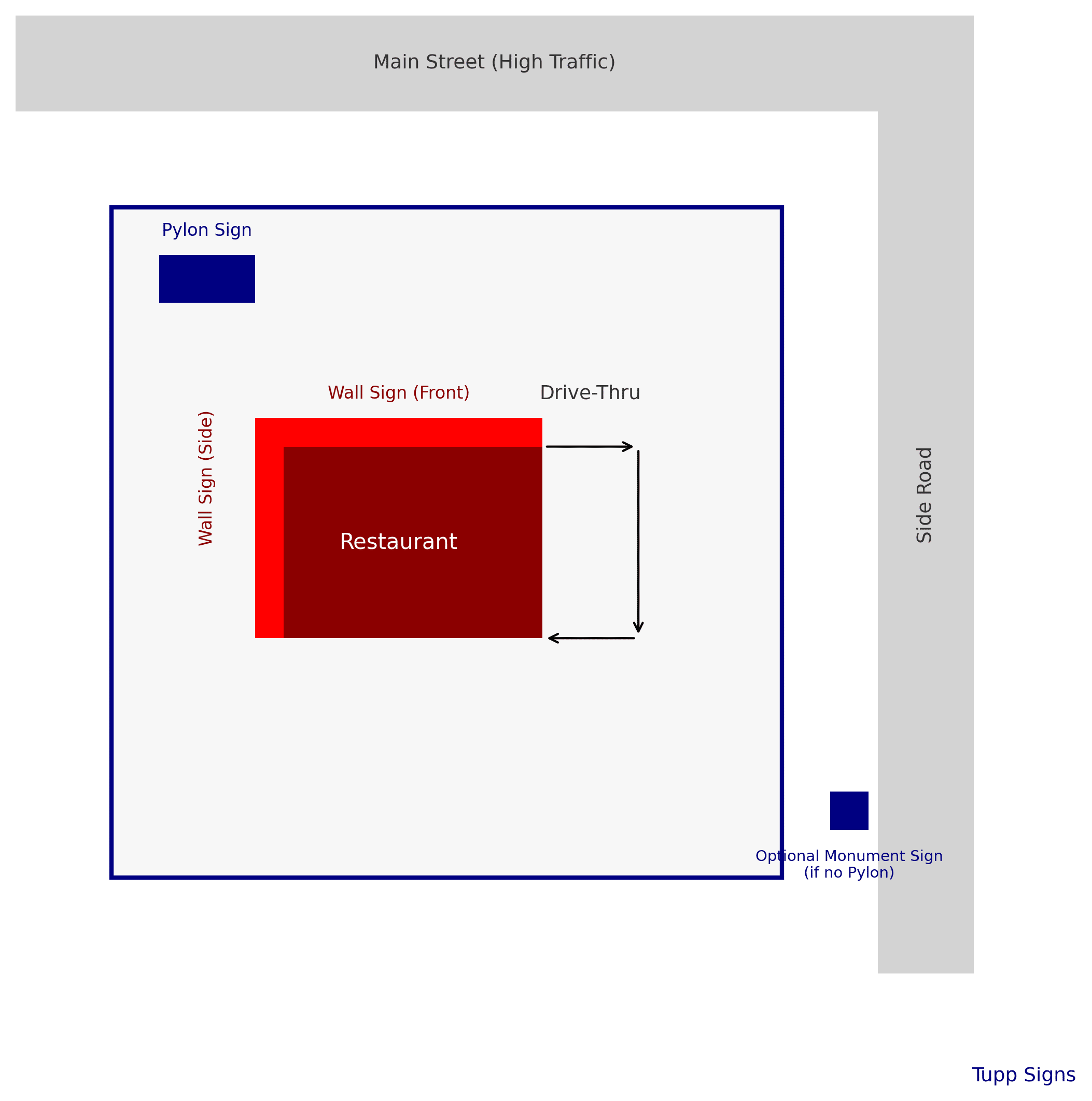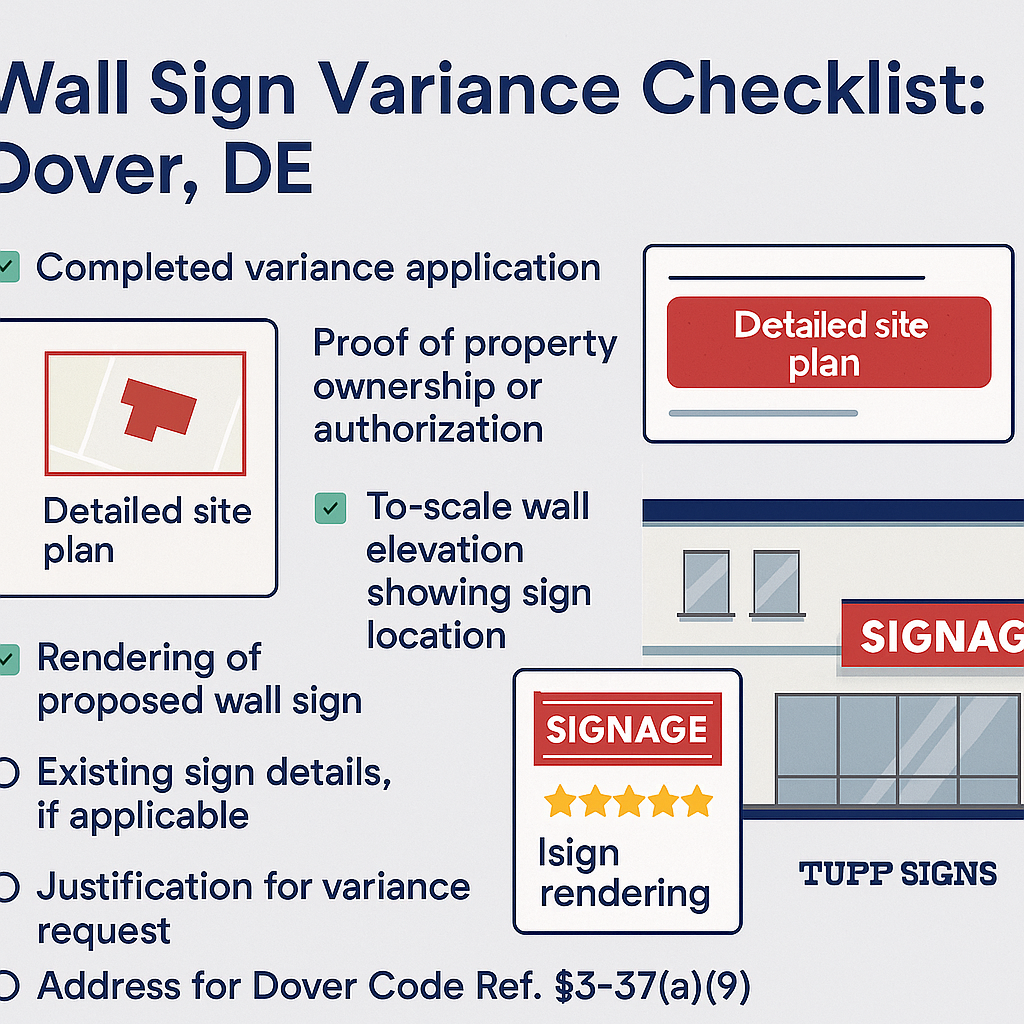How to Maximize Exposure Without Triggering a Zoning Rejection
Great Location, Bad Sign Plan? Avoid the Corner Lot Trap
You’ve secured the ideal corner lot in Dover—two streets, double the traffic, unlimited exposure. But when your sign permit comes back denied, you’re left frustrated, confused, and facing costly revisions. Why?
Corner lot signage operates under a more complex set of rules than standard parcels. Without a full understanding of Dover’s sign ordinance—particularly Ordinance #2009-19—even the best-designed signs can violate code on sight triangles, frontage allocations, or square footage.
At Tupp Signs, we help businesses unlock the full branding potential of corner lots—without triggering legal or permitting issues.
📌 Quick Summary
Applying for a wall sign variance in Dover, DE? Our downloadable checklist walks you through every step—from site plans to zoning code tips—so your application is complete, code-aligned, and ready for approval. Created by Tupp Signs, this guide helps you build a stronger case with less stress.
Why Corner Lot Signage Demands Special Attention
Corner lots are valuable because they face multiple roads and traffic patterns. But that visibility introduces more constraints:
- Two (or more) frontages = layered rules
- More viewing angles = placement and orientation complexity
- Proximity to intersections = stricter setback and safety requirements
If not addressed early in the design process, these variables can double your permit risk and halve your sign’s effectiveness.
Dover’s Rules for Signage on Corner Lots
Based on Ordinance #2009-19, Dover defines:
- Corner Lot: A property fronting two intersecting streets
- Permitted Sign Area: Based on primary frontage, with potential allowance on secondary frontage
- Height Limits: Dependent on road type and zoning district
- Setbacks: Often 10–15 ft from curb or ROW, stricter at intersections
- Visual Clearance (Sight Triangle): No signage allowed within designated clear zones
Understanding Multi-Face Signage in Dover
Multi-face signage (such as double-faced or V-style signs) is permitted but carefully regulated. Here’s what you need to know:
Allowed:
- One sign readable from multiple directions if within total allowed square footage
- Dual-faced signs if faces are oriented at 90–120 degrees apart
Not Allowed:
- Two signs on a corner lot unless frontage and sign area calculations permit
- Overlapping sign faces that exceed allotted sign area
- Internally lit EMCs without review and community compatibility assessment
Lighting rules apply: signs near residential areas or historic districts may require external, shielded, or time-limited illumination.

Realistic Scenario: Designing a Sign for Route 13 & Division Street
Let’s say you’re planning a new sign for a retail center on a prominent Dover corner.
Steps to Compliance:
- Check Zoning: Confirm parcel zoning type (e.g., C-3 or OP)
- Review Road Classification: Route 13 is a major arterial—height and face size may vary
- Map Sight Triangles: Ensure no part of your sign violates visual clearance zones
- Design a V-face Sign: Orients messaging to both streets while staying within square footage limits
- Submit Drawings: Include engineered plans, lighting specs, and materials list for fast review
🧾 What’s Inside the Checklist PDF
- Step-by-step variance preparation list
- Site plan and sign rendering tips
- Dover-specific zoning requirements from Article 5 §4.7
- Common pitfalls to avoid
- Tupp Signs contact info for expert assistance
📞 Call Tupp Signs at (302) 322-1600 or 📩 Download the Checklist Now
Navigating Unique Site Circulation: Drive-Thrus, One-Ways, and Looping Traffic
For businesses on corner lots with drive-thru lanes, one-way access roads, or loop-style traffic flow, signage needs to do more than brand—it must actively direct movement without creating congestion or code conflicts.
Why This Matters
Properties with multi-frontage access often have:
- Entrances and exits on different streets
- Complex drive-thru layouts with menu boards, clearance signs, and directional instructions
- One-way loops that must be reinforced with signage to avoid accidents or blockages
Without intentional signage planning, customers can get confused, frustrated—or worse, create unsafe traffic conditions.
Signage Tips for Drive-Thru Corner Lots
- Directional Blade Signs at Key Turns
Clearly mark “Drive-Thru →”, “Exit Only”, and “Do Not Enter” points at both frontages.
- Wayfinding Markers at Secondary Entrances
Small monument or ground signs near secondary streets help with orientation from both traffic approaches.
- Minimize Obstruction of Sight Lines
All signs near intersections or exits must stay out of the visual clearance triangle.
- Menu Boards + Clearance Bars
These must be located on internal drive lanes, not facing the public right-of-way, and are subject to separate sign area limits in Dover. - Multi-Face Orientation
Use V-style or perpendicular signs to speak to traffic from both streets without doubling your square footage.
Common Corner Lot Signage Mistakes
| Mistake | Why It Fails |
| Adding two full-sized signs | Most parcels are only entitled to one sign per corner lot rules |
| Violating the sight triangle | Creates safety hazards at intersections |
| Exceeding sign face area with multiple views | Square footage applies cumulatively |
| Overlooking setbacks | May require removal or relocation after installation |
| Installing EMCs without permits | Subject to stricter approvals and time restrictions |
Best Practices for Multi-Face Corner Lot Signs
- Begin with a site and zoning analysis—don’t assume past signage sets precedent
- Design for orientation, not duplication—V-signs can face both streets without overage
- Use code-compliant materials like HDU, aluminum, or routed PVC for durability and aesthetic fit
- Light smart—shielded external or time-controlled lighting in sensitive areas
- Work with an expert who knows Dover’s permitting and sign code intricacies
How Tupp Signs Delivers Legal & High-Impact Signage
While every corner lot is different, our process ensures no surprises:
- Zoning + Overlay Review
- Custom Multi-Face Sign Design
- Permit Documentation + Submissions
- Code-Compliant Fabrication
- Professional Installation + Inspection Coordination
🔗 Explore our Monument + Pylon Sign Solutions
Visual Recommendations
- Diagram: Sign placement on a corner lot showing setbacks, sight triangle, dual-view angles
- Infographic: “Dover Corner Lot Sign Rules: What You Can and Can’t Do”
- Comparison Chart: Single frontage vs. corner lot signage allowances
Final Word: Don’t Let Your Best Lot Become a Headache
Corner lots offer unmatched visibility—but only when signs are designed with code compliance in mind. At Tupp Signs, we help businesses maximize exposure while protecting against costly design missteps, permit denials, or forced removals.
Build With Confidence. Build With Compliance.
📞 Call Tupp Signs at (302) 322-1600
📩 Request a Corner Lot Signage Review
❓ Frequently Asked Questions
Who should use this checklist?
Business owners, property managers, and designers planning more than two wall signs on a building in Dover, DE.
Does it cover Dover-specific rules?
Yes. It includes zoning guidance based on Article 5 §4.7 and tips specific to Dover’s Board of Adjustment process.
Can Tupp Signs help with the application?
Absolutely. We assist with documentation, site plans, renderings, and coordination with local planning offices.


